Changing Tides
By Marissa Garcia
October 2020 Editor’s Note: This article was revised on Feb. 10, 2025.
Nadia Alomari remembers how it felt to be aboard the R/V Manta in Flower Garden Banks National Marine Sanctuary, with miles of blue stretching as far as she could see. Just a few years prior, she had never imagined that she would be a research assistant, much less embarking on an oceanographic research expedition in the Gulf of Mexico, more than 1,000 miles away from her college based in Brooklyn, New York.
“Laughter and smiles filled the boat. Everyone was eager to assist the other with whatever task was at hand. When the clock hit 7:00 p.m., everyone put their computers down and it was time to unwind. We watched movies, played cards, had a BBQ in the middle of nowhere, and watched the sunset. The memories and experiences I had aboard the R/V Manta cruise are ones I will never forget,” recalls Alomari, a recent graduate from NYC College of Technology (CUNY) with a bachelor’s degree in biomedical informatics. Alomari was part of the team from the sanctuary -- about 70 to 115 miles off the coasts of Texas and Louisiana -- that collected a newly-described species of black coral, Distichopathes hickersonae, named in honor of Emma Hickerson, research coordinator at the sanctuary.
After the specimen was collected, it was sent to the Smithsonian Institution’s National Museum of Natural History, where it was processed under the direction of Dr. Dennis Opresko, a world-renowned black coral taxonomist. The results revealed that the collected specimen was in fact a new species, the 14th black coral identified within the current and proposed sanctuary boundaries.
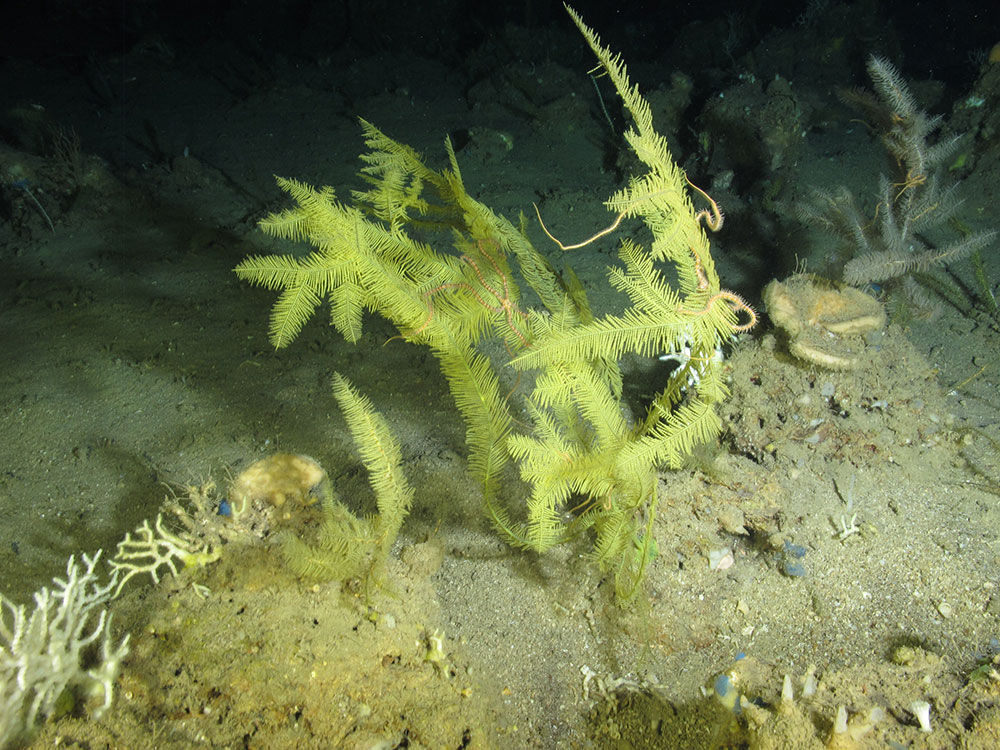
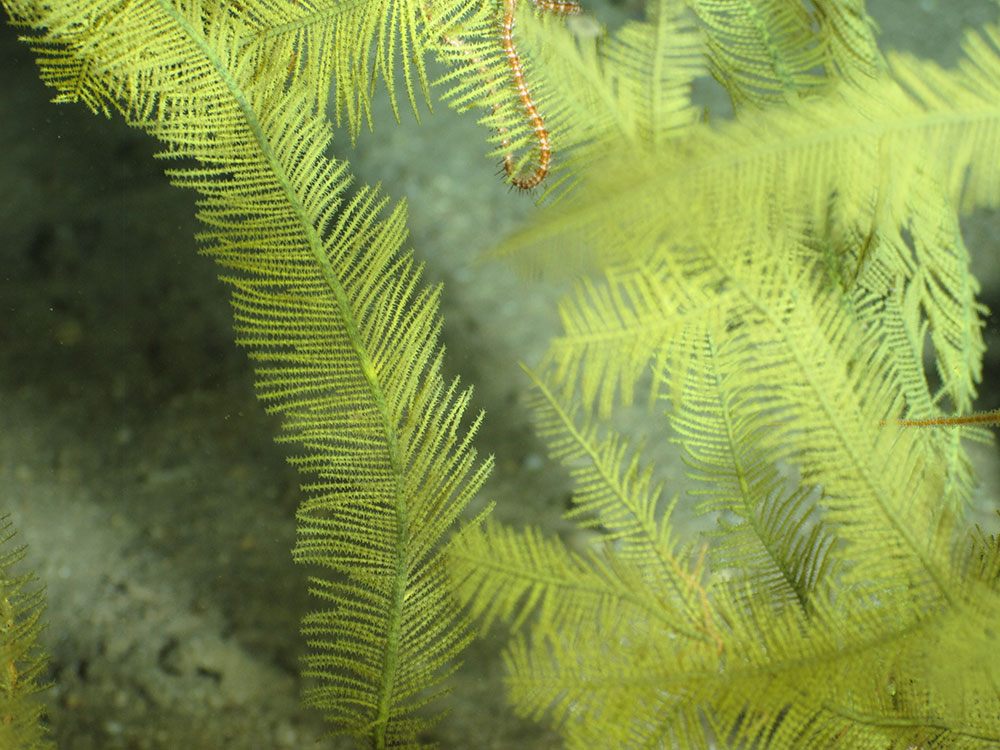
The remotely operated vehicle (ROV) Mohawk captured up-close footage of the newly discovered black coral Distichopathes hickersonae. Photo: NOAA/UNCW-UVP.
However, Alomari would not have experienced the wonders of this ecosystem if it weren’t for the first day she stepped into Dr. Mercer R. Brugler’s biology class for non-majors at CUNY. She recalls, “I had no idea how my life would change when I walked into his classroom. Prior to attending his class, I had no intentions of pursuing research.”
This changed when she realized that Brugler taught his classes quite differently than most professors. As soon as he steps into the classroom, Brugler introduces himself by sharing all the reasons why he loves biology. He says, “I start the class with a visual presentation on the open ocean, the mesophotic reefs from the Flower Garden Banks, the deep sea, and I say, ‘If you’re interested in the ocean, if you want to potentially get out to sea and see this stuff with your own eyes, let me know.’”
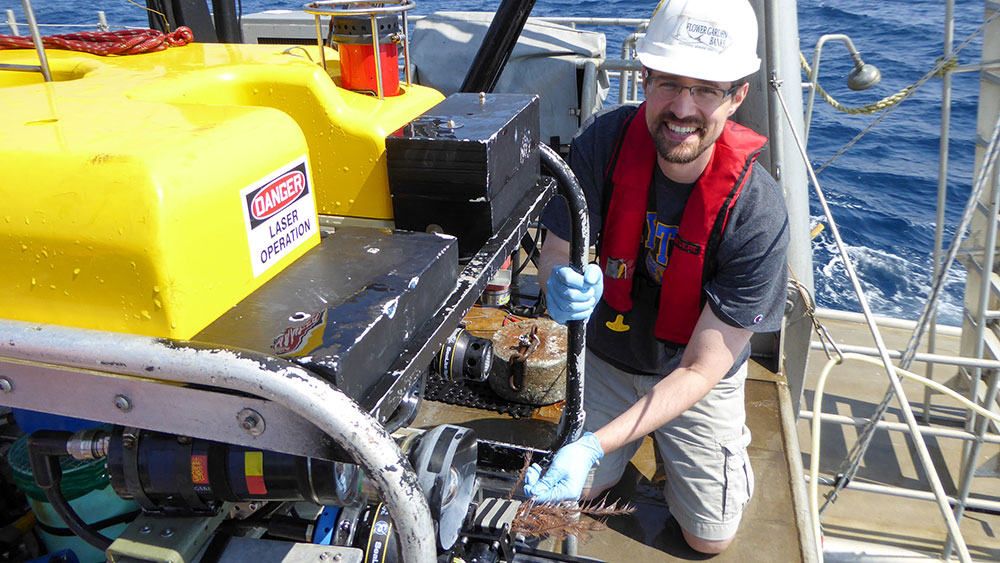
Alomari had never been out to sea before, and she had little prior field experience, but her interest was piqued. No problem. Brugler doesn’t let a student’s lack of research or field experience become a barrier.
“The question I always get is, ‘What sort of experience do I need?’ None! None whatsoever! All I need is a passion for something related to the ocean or the techniques we employ (e.g., DNA sequencing),” he says.
Following a visit to Brugler’s office and an interview later, Alomari secured a position as a research volunteer in Brugler’s Black Coral Lab at the American Museum of Natural History in New York City. This marked the beginning of Alomari’s journey conducting research on deep-sea and mesophotic corals -- communities of coral that occur deeper than typical stony coral reefs. Just a few months later, she would board Manta, the sanctuary’s research vessel, about to collect a sample of a previously undescribed black coral species.
Live from the ocean floor
The ROV Mohawk, which was used to identify the black coral, can dive nearly 1,800 feet below the ocean’s surface. Photo: Emma Hickerson/NOAA
Aboard the R/V Manta, marine scientists huddled around a screen. From below the surface, the remotely operated vehicle (ROV) Mohawk, an underwater robot, beamed live footage of the ocean floor. Vibrant coral reefs rested atop salt domes that formed approximately 190 million years ago. Clouds of anthiid and hunchback scorpionfish were documented in real time by scientists as the ROV navigated over the seascape.
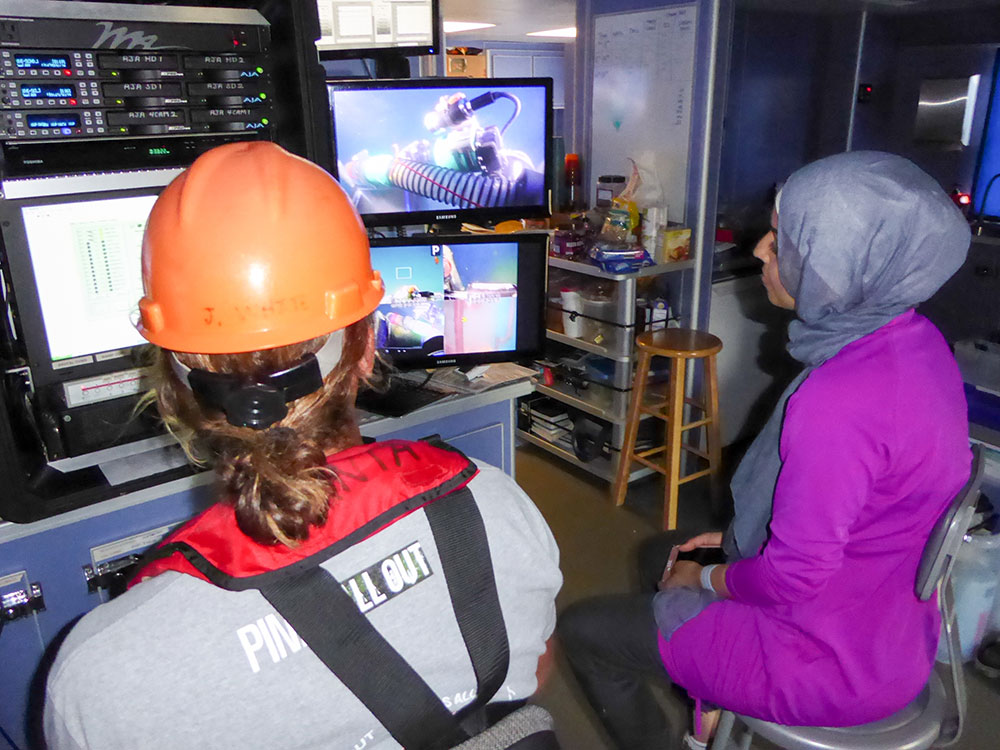
About 400 feet beneath the surface, an unfamiliar black coral with bright green tissue appeared on the screen. “We all got quite excited,” recalls Hickerson, the sanctuary’s chief research scientist. “It was obviously something we wanted to take a closer look at, so we had the ROV take some great photographs.” Black corals are named for the ebony color of their internal proteinaceous skeleton, not their external appearance, which can be a variety of colors.
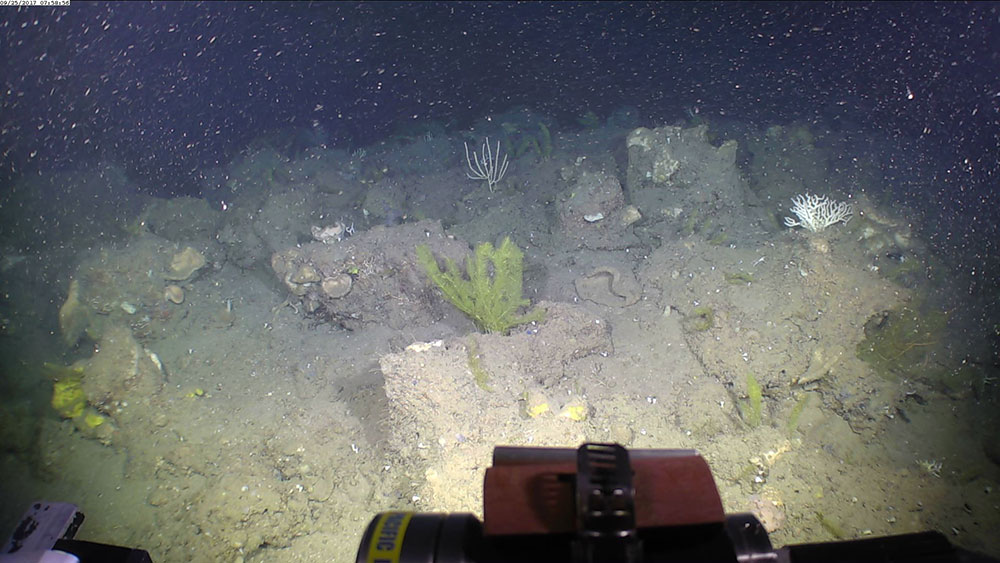
This unfamiliar black coral subsequently would be confirmed as a new species and named after Hickerson, who has worked at the sanctuary since 1997. The sanctuary is supportive of providing student opportunities.
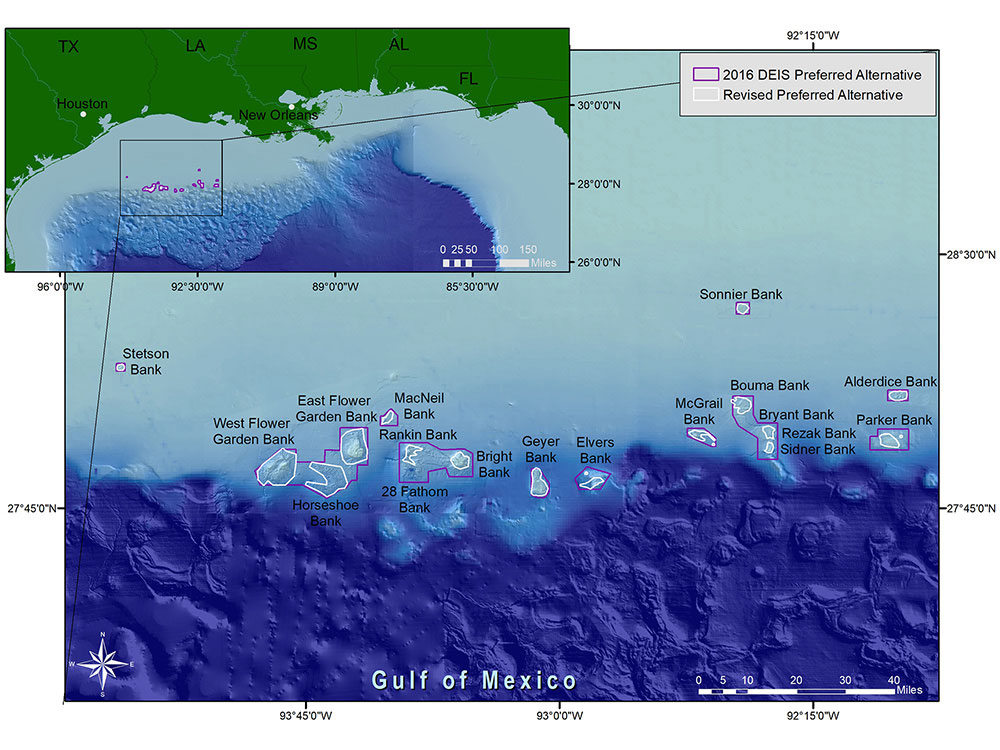
The new black coral, Distichopathes hickersonae, was discovered at a depth of 564 feet on Elvers Bank, one of 14 banks included in a proposed sanctuary expansion. Hickerson said the proposed expansion would provide important habitat for recreationally and commercially important fish, as well as threatened or endangered species of sea turtles and corals. She also emphasized that the expansion would facilitate more comprehensive management of important and vulnerable habitat sites across the Northwestern Gulf of Mexico, a heavily utilized and industrialized region. The sanctuary is currently reviewing the public comments received this summer. NOAA will consider these comments to inform the development of the final expansion plan.
Not just one color
Nadia Alomari and Mercer Brugler showcase the sample of the new black coral species. Photo: G.P. Schmahl/NOAA.
The black coral represents abounding biodiversity still left to be discovered in the sanctuary and in our ocean, much of which remains largely unexplored. To support future discoveries and to harness the complete intellectual capital of the nation, many in the scientific community, including agencies like NOAA, are discussing ways to build a science, technology, engineering, and mathematics (STEM) workforce. NOAA has championed its Educational Partnership Program with Minority Serving Institutions to increase the number of students from historically underrepresented groups to apply to and join the NOAA workforce. While some progress has been made toward these goals, agency leaders acknowledge that more needs to be done to ensure that NOAA is a diverse, inclusive place to work.
“Our unique mission of science, service and stewardship requires our being able to attract and retain a diverse workforce that reflects the best and brightest of American society and understands the varied perspectives of the communities and stakeholders we serve,” said John Armor, director of NOAA’s Office of National Marine Sanctuaries. “This is critical in our ability to understand and anticipate changes in the Earth’s environment, improve society’s ability to make scientifically informed decisions, and conserve and manage marine and coastal ecosystems for future generations.”
Three years after the expedition in the sanctuary, Alomari has graduated and is currently working as a lab intern at the DNA Learning Center at Cold Spring Harbor Laboratories. She hopes to continue her education and is currently applying for a master’s degree as a physician assistant, while also continuing her passion for research.
Her time spent in Brugler’s black coral lab was foundational in taking this path. Brugler would seek several students' perspectives on research topics, maintaining the spirit of collaboration. His words still resonate with her. Alomari recalls him saying, “The way you see something, the way I see something, may be completely different. He insisted that different life experiences and viewpoints are key to resolving outstanding scientific questions.
Alomari wants other students from underrepresented backgrounds to feel motivated to pursue their dream careers in science, as their voices are invaluable. She believes, “You don’t generally see people who look like me in this field. This was the driving force I needed to explore my passion for science while representing where I come from and my story. If you don’t see people who look or sound like you, it’s time to dive in with both feet because science is not just one color. It’s every color.”
Marissa Garcia is a student at Harvard College and a Virtual Student Federal Service intern for NOAA’s Office of National Marine Sanctuaries.
Dr. Mercer R. Brugler is now an associate professor of marine biology at the University of South Carolina Beaufort where he continues his mission to recruit underrepresented minorities.

